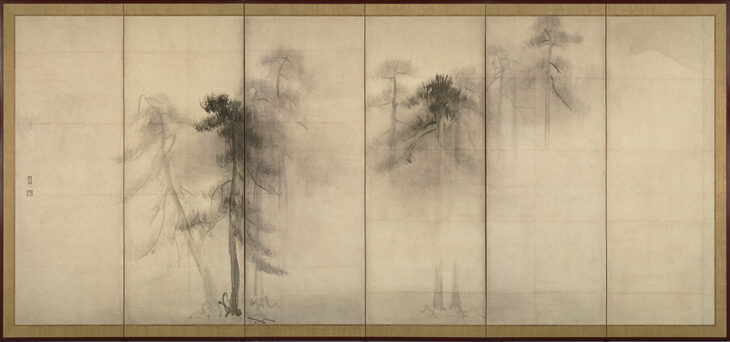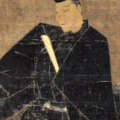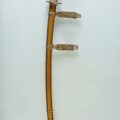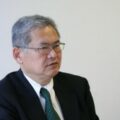An Introduction to the Irresistible Charm of Japan’s National Treasures
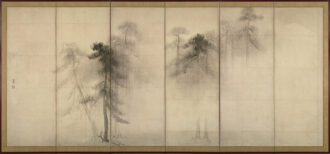
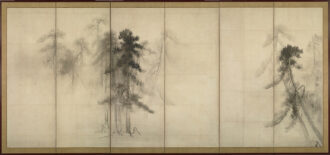 Shorin zu byobu (Pine Trees) by Hasegawa Tohaku (1539–1610)
Shorin zu byobu (Pine Trees) by Hasegawa Tohaku (1539–1610)
Source: ColBase (https://colbase.nich.go.jp/)
How do national treasures become national treasures? What 89 masterpieces can teach us.
Kobayashi Tadashi, Art Historian
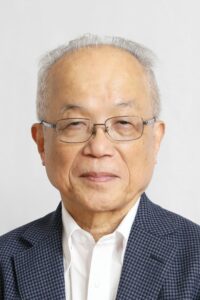
Kobayashi Tadashi,
Art Historian
From October to December 2022, a special exhibition titled “Tokyo National Museum: Its History and National Treasures,” is being held at the Tokyo National Museum. All 89 national treasures in the museum’s collection will be exhibited together.
I am currently the director of the Okada Museum of Art in Kanagawa Prefecture. Previously, I was the director of the Chiba City Museum of Art. I have taught at universities, including Gakushuin University, and I once worked at the Tokyo National Museum. As a graduate student, I became a part-time researcher at the Tokyo National Museum, and in 1969 became a curator of painting there. For a while I left for Nagoya University, but returned to the museum, working there for more than ten years in total.
During that time, I was permitted to enter the storage rooms alone, so I had the chance to spend plenty of time with many works. I was entrusted with the display of paintings from the Momoyama (1568–1600) and Edo periods (1603–1868). I had the pleasure of putting together exhibitions while thinking about the effects of different presentation methods. That former haunt packed with memories is always in my thoughts. So, when I heard that the museum was planning an exhibition on such a large scale, I wanted to give it my patronage and support. This isn’t the first time that the museum has held a kind of National Treasure Exhibition. It houses many national treasures, so it holds similar exhibitions now and then. National treasures are an extremely effective way to draw visitors. The words “national treasure” attract plenty of media coverage and many visitors.
In that sense, there’s no doubt that an exhibition of Japan’s most famous masterpieces is a valuable way for a large number of people to experience art.
How are national treasures chosen?
National treasures are a great draw — but what exactly are they? Let’s reconsider that in detail.
The Law for the Protection of Cultural Properties regulates national treasures. As defined by the law, national treasures, “among Japan’s important cultural properties, are of high value from the perspective of world culture, and are incomparable treasures of the Japanese people.”
National treasures are selected from among these important cultural properties designated by the national government as specially important cultural properties. They are well-preserved items of exceptional historical and artistic merit, where the creator, date, and production background are clearly established.
That is a considerable hurdle, so in fact the number of national treasures is not large. While there are over 13,000 important cultural properties, national treasures number 1,100. Some people who like climbing mountains want to climb all Japan’s 100 famous mountains. Similarly, perhaps because 1,100 is a number that suggests all can be seen, some people make it their life’s goal to encounter all the national treasures. This exhibition is a great chance to see 89 national treasures in one go.
But what is the process for deciding a national treasure?
First of all, technical specialists from the Agency for Cultural Affairs do research and hold internal meetings to narrow down a list of candidate works. The committee produces a draft, and the Minister of Education, Culture, Sports, Science and Technology consults the Agency for Cultural Affairs.
The Agency for Cultural Affairs requests the Subcommittee of the Cultural Properties Expert Committee to deliberate. This committee discusses the candidates and prepares its findings. An official gazette announcement is made, resulting in new important cultural properties and national treasures coming into being.
The committee is divided into specialized fields such as traditional crafts and archaeology, each with about 10 specialists. Until I retired at the age of 70, I belonged to the Painting and Sculpture Group.
Debate occurs each year, but the atmosphere (at least in the group to which I belonged) is very calm. Based on a detailed investigation by a technical specialist, the group checks that there are no problems. Proposals are very rarely rejected these days. But it seems that there was a time when, in some groups, particularly formidable experts used to kick out proposals, saying things like, “We can’t approve that!”
Genre selection bias
To be honest, when national treasures are selected through this kind of process, there’s strong bias related to period and genre. At the end of the day, national treasures are selected by people, and fashions of the time have an effect.
Looking down the list, I immediately notice how many swords there are. There are well over 100, which is more than 10% of all Japan’s national treasures.
This is related to the historical context. Having accepted the Potsdam Declaration, postwar Japan had to turn over all its weapons to the Allied Forces. Swords were also included, but all efforts were made to exempt from confiscation famous swords with value as works of art.
When doing this, there were various approaches, but one of the most effective was designation as a national treasure. The Cultural Properties Protection Committee recommended a series of famous swords as national treasures in order to preserve them.
Another example is how five earthenware figures from the Jomon period (around 14,000 to 300 BCE) have been designated as National Treasures, but only one haniwa (hollow unglazed terracotta figures) from the Yayoi to Kofun (third century BCE to sixth century CE) period has been designated. In the Kofun period, there were powerful families in various regions, and perhaps committee members’ regional ties make it difficult for famous items to be promoted.
The number of national treasures from my specialty, art of the Edo period, is also quite small. Ukiyo-e woodblock prints are appreciated and popular throughout the world, yet not one to date has been designated as a national treasure. There are only a handful of Edo-period important cultural properties too.
Ukiyo-e prints are premised on reproducibility, so it’s understandable that members are hesitant about designation. There would be a problem if, having designated a piece, another with better printing or preservation appeared.
However, even if we broaden our view to include pictorial works that are not printed, there’s still a big gap between works of ukiyo-e artists and other national treasures.
Perhaps this is related to how ukiyo-e prints were made for the pleasure of common people in the Edo period.
Broadly speaking, there are two types of Japanese art. One is items used in religious ceremonies. They are made for Buddhist or Shinto deities, and cause one to feel reverence, awe and spiritual power. Since ancient times, they have been protected by rulers and cherished by the many. For those reasons, many masterpiece Buddha statues and paintings have been selected as national treasures.
On the other hand, art works from daily life belong to their own times. They were created to comfort hearts and give people pleasure. They were not protected by the “important people” of their times; and to an extent this trend continues today, making it hard for them to rise to the level of national treasures.
I’d also like to cover the historical background to the national treasure system’s creation. Its beginnings go back to the Meiji Restoration.
It was an era of one-sided “Westernization” and “Out-of-Asia, Into Europe.” A tendency developed to think that anything old was bad, while anti-Buddhism spread throughout Japan, resulting in the destruction of temples and Buddhist statues.
Foreigners were completely free to buy up famous items and take them abroad. In 1871, concerned about this outflow of culture, the government issued a Proclamation by Dajokan (Grand Council of State). This Edict for the Preservation of Antiquities and Old Items was an attempt to stop items leaving Japan.
Following this in 1897, the government promulgated the Law for the Preservation of Old Shrines and Temples. Oriental art historian Ernest F. Fenollosa (1853–1908) and art critic Okakura Kakuzo, known as Okakura Tenshin (1863–1913), conducted a field survey of the entire country, establishing which cultural properties should be protected by the government.
In 1929 the Law for the Preservation of National Treasures was created, and then in 1950 the current Law for the Protection of Cultural Properties. During those chaotic times after the war, there was a major impetus for the swift enactment of a law.
In 1949, a mural in the Kondo (Main Hall) of Horyu-ji temple was destroyed by fire. In fact, it was lost during work to create a replica. In other words, the original was lost while the copy was being made.
It became a major issue for Japanese society, and recognizing the seriousness of the situation, the government hastened legislation. One year later in 1950, Kinkaku-ji temple, an irreplaceable structure built during the Muromachi period (1336–1573), also went up in flames. So, several things happened at the same time that together increased momentum for the preservation of cultural properties.
The 1950 Law for the Protection of Cultural Properties demoted all cultural properties designated as national treasures prior to WWII to important cultural properties. National treasures were then reselected from among these.
Below, I have selected four national treasures from the current exhibition that I’d like to focus on in particular.
Four pieces of note from the exhibition

Haniwa buso danshi ryuzo (Standing Guard in a Full Set of Armor)
Source: ColBase (https://colbase.nich.go.jp/)
The first treasure is Standing Guard in a Full Set of Armor, also known as Warrior in “Keiko” Armor. It is believed to date from the sixth century and was excavated in present-day Ota City, Gunma Prefecture. Of the many haniwa clay figures across Japan, this is the only one that is a national treasure in and of itself.
The warrior stands resolutely in full armor of the time, wearing a helmet and set of armor, including armor on the back of hand and wrist. He has a bow and arrow, and has his hand on his sword. In addition to its beauty as a sculpture, it is also very important as a clue to the customs of the time.
There are almost no written records from the Jomon, Yayoi, and Kofun periods. We rely only on objects to learn about the environment and people’s lives in those days. Cultural properties such as Warrior in “Keiko” Armor that convey the atmosphere of their age are even rarer.
The museum has many other impressive haniwa in its collection that I personally believe deserve to be national treasures, including a realistic model of a monkey’s head. In any case, we may see more national treasures from the Kofun period in future.
Transcendent technique that is impossible to reproduce
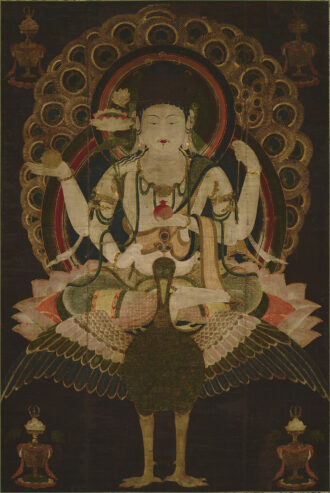
Kujaku Myoo zo (The Peacock Wisdom King)
Source: ColBase (https://colbase.nich.go.jp/)
The Peacock Wisdom King is a large Buddhist painting from the cloister rule time of the Heian period (794–1185). Made in the twelfth century, it is approximately 1.5 meters in height and 1 meter in width. It is a front image balanced on both sides showing the main deity of the Peacock King Sutra, who governs the warding off of disaster and prayers for rain.
When I was a curator at the museum, I put this Buddhist painting on display many times for exhibitions. Up close, the preservation condition was extremely good. The elegant colors of the piece were striking and captivated me every time.
The delicate kirigane patterns applied to the robe of the Peacock Wisdom King are also magnificent. Kirigane is a traditional craft technique of making patterns from gold and silver leaf cut into narrow strips. Because the gold leaf would stick to the blade of a metal tool such as scissors or a utility knife, it is cut with a sharpened bamboo tip.
If you look at the actual piece, you’ll find that the kirigane gold and silver leaf is cut with incredible delicacy. Although kirigane techniques have been passed down to the present day, it would likely be impossible to reproduce such a detailed and beautiful finish.
The patience and skill needed to complete such a work is almost unimaginable. Quite possibly, the artist did not paint this picture to meet worldly demands, such as a commission or a tribute. I suspect he painted it as a kind of prayer.
I can imagine a person with deep faith in the Peacock Wisdom King negating his self and purifying his body as he added brushstroke upon brushstroke of paint with heartfelt prayers. There’s no doubt that it was painted not to please the viewer, but as a giving of time to the Buddha and a demonstration of faith. It was this desire that made it possible to devote such exceptional time and effort to creating this work.
As time goes on, we become painfully aware of these prayers of our ancestors that exude from the Peacock Wisdom King.

Shorin zu byobu (Pine Trees), the left side of the screen is shown above, and the right side is shown below.
Source: ColBase (https://colbase.nich.go.jp/)
Pine Trees by Hasegawa Tohaku (1539–1610) is another very pleasing piece in the collection. Of all the museum’s pieces, this is my favorite. It represents the apex of Japanese ink painting, a national treasure among national treasures.
At first glance, the folding screen has a light feel to it, as if it were painted all at once using only black ink. But when you stand in front of the painting for a while, the way the ink has soaked into the paper, the distorted lines, and the generous empty space, gives the feel of an atmosphere heavy with moisture extending across the entire picture.
There really are invisible things there: humidity, heat, and a breeze blowing through the painting. The Japanese climate is expressed as it is.
Around the late Kamakura period (1185–1333), Chinese ink painting techniques began to be adopted in Japan. After studying and absorbing Chinese painting techniques, Tohaku developed his own style of painting with soft brush strokes of ink diluted with water, rather than the Chinese style of painting, which has a rich variation of ink shading and brush pressure. These aspects mean his works are more appropriately called “paintings” than “Chinese ink paintings.”
Such “white sand, green pine” coasts, as they are known in Japanese, were once located over Japan. Fog and mist were said to hang over these coasts from morning to night. So, you might call Pine Trees an original Japanese landscape. Perhaps that’s why every Japanese person who stands in front of this folding screen feels a sense of nostalgia.
A mysterious theory behind a folding screen
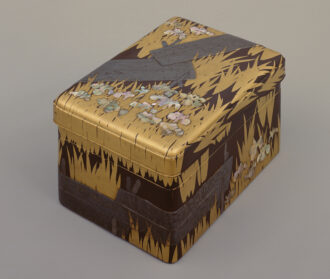
Yatsuhashi maki-e raden suzuribako (Writing Box with the Eight-Plank Bridge, Lacquered wood with maki-e, lead, and mother-of-pearl)
Source: ColBase (https://colbase.nich.go.jp/)
There is something curious about this work. The painting is on thin writing paper and the joins between the sheets are irregular. Currently, the prevailing theory is that it is a draft for a shoheiga (painting on wall or sliding door.)
In the West, many preliminary sketches for paintings still exist, but in Japan since ancient times, it has been customary to casually discard preliminary sketches.
It’s a feature of Japanese culture. Athletes and actors have an aesthetic that says it is best not to show people training and rehearsals. It’s the same in the art world, and it’s normal for drafts to be disposed of. But Pine Trees is an exception. Someone must have spotted the painting’s worth, and scrambled to save it saying, “It’s a rough sketch, but surely we can’t throw it away; we have to preserve it.”
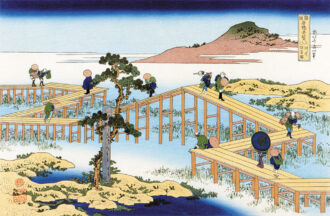
Shokoku meikyo kiran: Mikawa no Yatsuhashi no kozu (Wondrous Views of Famous Bridges in Various Provinces: Old Picture of Eight-plank Bridge in Mikawa) by Katsushika Hokusai, Public domain
The work’s painter, Hasegawa Tohaku, was wonderful, but it was also a noble thing that someone tried to preserve and pass the work down.
Lastly, there is the Writing Box with the Eight-Plank Bridge, lacquered Wood with maki-e, lead, and mother-of-pearl.
This is a masterpiece that epitomizes the brilliant “Genroku culture” of the Edo period, which is the culture of merchants that flourished mainly in Osaka from the late 17th century to the early 18th century. It is the work of the multi-talented Ogata Korin (1658–1716,) who these days would be called a “multi-designer” or an “art director.”
This design comes from the Yatsuhashi scene in Ise Monogatari (The Tale of Ise,) in which a despondent man is traveling from Kyoto to eastern Japan. At Yatsuhashi in Mikawa Province (currently Chiryu City in Aichi Prefecture) he is moved by a magnificent view of streams flowing out in different directions like spider legs, the wooden bridges over the streams, and the colony of rabbit-ear iris that decorate the surface of the water. This work portrays that scene on the surface of an inkstone box. Gold maki-e lacquer has been scattered all over the box. The bridge is represented by thin strips of lead and its piers by thin strips of silver. The leaves and stems of the irises are inlaid with flat gold maki-e lacquer, and the flowers are delicate raden mother-of-pearl inlay of cut-and-pasted abalone shells. Maki-e is a Japanese lacquer craft in which lacquer is decorated with gold, and has a long history. The techniques have been handed down and refined since the Nara period (710–794). This accumulation of technique is lavishly employed here to achieve a splendid result.
Korin’s incredible ability to intimate the unseen
Ogata Korin did not perform each step of the production process himself, but rather he commissioned and directed work from the day’s best craftsmen in various fields. His ability as a director and his aesthetic capacity to conceptualize the whole project shines through.
Korin was a son of the Karigane-ya, a famous Kyoto kimono store that supplied short-sleeved kimono to the shoguns, as well as the imperial family and other nobles of the time. The environment in which he was born and raised is the source of Korin’s outstanding sense for design. Writing Box with the Eight-Plank Bridge is based on the Ise Monogatari (The Tale of Ise), but no figures are depicted. This is a typical example of a work that uses a technique known as “rusumoyo.”
Japanese culture has a deep-seated tendency to minimize words and decorative elements through layers of abbreviation, allowing the viewer to enjoy these elements via his or her imagination. Tanka and haiku poetry are the ultimate examples of this. But craft design also consists only of “parts” that activate the imagination of the user and invites him or her into a poetic world.
Every person who sees this simple design thinks of the Yatsuhashi bridge in the Ise Monogatari, and imagines the sad sight of a nobleman who has departed the capital leaving behind his beautiful love. The fact that such interpretations and imaginings have been passed down over time is what makes Japanese culture so special and wonderful.
Each one of these national treasures is surely an acme of Japanese beauty. Viewing them, we gain a perspective on the kind of things that have been considered beautiful in Japan since ancient times. Generally speaking, one “form of beauty” is to be familiar with seasonal changes in climate, such as the twenty-four seasons of the lunar calendar and 72 micro seasons of the twenty-four seasons, while also greatly admiring the objects of nature, as symbolized by flowers and birds, and to express these in poetic form. This is the nature of Japanese beauty: to amplify the joys contained in human lives.
Japanese beauty from hand to hand
Having described these characteristics of Japanese beauty, it is interesting, I think, to consider how Japanese cultural properties have been handed down and protected.
Japanese cultural properties have not survived automatically without doing anything. For example, whenever a disaster—whether natural or manmade— occurred, Buddhist statues that served as the principal object of worship in temples, paintings, and scrolls were always the first things to be carried out and taken to safety.
These items have come down through the ages and still exist today exactly because large numbers of people have always worried about them and carefully protected them.
When a national government passes and puts into practice a law for the protection of cultural properties, that in itself is not enough to protect cultural properties. In Japan, not only public organizations, but also individual temples, shrines, and individuals have continued to cherish irreplaceable things, and linked their efforts in this field of beauty.
Here is one possible proof of that. Around the world, ancient cultural properties are often found in the ground, but in Japan, the overwhelming majority of cultural properties have been handed down from hand to hand.
The Peacock Wisdom King painting mentioned above has also been handed down for about 800 years since the Heian period.
I would like to re-emphasize that Japan’s cultural assets did not somehow “survive,” but were “preserved” through our predecessors’ desperate efforts to look after them. The longer these items have been passed down, the more they are filled with people’s thoughts. One could say that they are good because they are old. National treasures exude charm, including the warmth with which they have been passed from one generation to the next and from one person to another. When you think of them this way, each and every item shines even more brightly.
Translated from “Omowazu mihoreru ‘Kokuho’ nyumon (An Introduction to the Irresistible Charm of Japan’s National Treasures),” Bungeishunju, November 2022, pp. 346–353. (Courtesy of Bungeishunju, Ltd.) [December 2022].
Keywords
- Kobayashi Tadashi
- Art Historian
- Okada Museum of Art
- Kokka
- Tokyo National Museum
- national treasures
- important cultural properties
- Agency for Cultural Affairs
- swords
- haniwa
- ukiyo-e
- Ernest F. Fenollosa
- Okakura Tenshin
- Horyu-ji
- Kinkaku-ji
- Peacock Wisdom King
- Pine Trees
- Hasegawa Tohaku
- Ogata Korin
- The Tale of Ise
